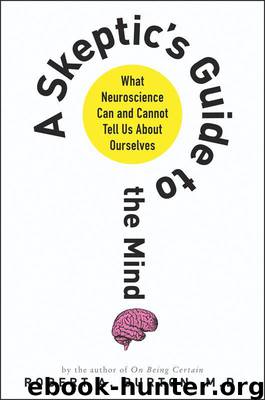A Skeptic's Guide to the Mind: What Neuroscience Can and Cannot Tell Us About Ourselves by Burton Robert

Author:Burton, Robert [Burton, Robert]
Language: eng
Format: epub
Publisher: St. Martin's Press
Published: 2013-04-22T20:00:00+00:00
9 • Under the Big Top
What’s he building in there?
What the hell is he building in there?
—Tom Waits, “What’s He Building?”
On my sixtieth birthday, my wife and I took my mother to a particularly upscale San Francisco hotel for lunch. We wouldn’t usually eat there, but the hotel had a convenient drive-up entrance and elevator for my mother to use her walker. Though we’d always been close, it would be fair to describe my relationship with my mother as undemonstrative. However, at the end of the meal, in an uncharacteristic gesture of affection and appreciation, I reached over, lightly touched her arm, and said, “If it weren’t for you, I wouldn’t be here today.” Her immediate deadpan response: “We could have eaten somewhere else.”
When she was ninety-seven and near death in the hospital, I mumbled an inanity meant to cheer her up. “You’re lucky to have your room right across from the nursing station.” Without any hint of making a joke, my mother replied, “Yes, location is everything.”
Allegedly one of man’s most unique attributes is his ability to read the mind of others (know what another is thinking). In philosophical circles this is referred to as theory of mind (TOM). But, even as a neurologist who reads philosophy and studies the mind, to this day, I have no idea if my mother was being humorous, sardonic, ironic, playful, insensitive, pragmatic, existentially whimsical, or matter-of-fact. Her deadpan delivery often made it impossible for her closest friends and family to distinguish between an intention to be funny or wry, or a genuine unawareness of possible double entrendres. In the end, each of us explained her Yogi Berra–like observations based upon his or her own unique lenses for seeing the world. As a result, she became the stuff of family legend, myth, and, ultimately, considerable confusion.
If we can’t be sure someone is pulling our leg, can we accurately predict behavior? In a 1993 study, members of the Department of Psychiatry, University of Pittsburgh School of Medicine, evaluated patients originally seen in the emergency department of a metropolitan psychiatric hospital. When ready for discharge, the patients were assessed for their potential for violence and accordingly assigned to one of two groups—violent or nonviolent. In a six-month follow-up, violent acts occurred in half of the cases predicted to be violent, but also in over one-third of the “nonviolent” group. Within this group, predictions of female patients’ violence were not better than chance. (Flipping a coin to decide violent or nonviolent had the same accuracy in prediction as did a psychiatric evaluation.) In another study, even such intuitively obvious differentiating factors as verbal threats versus actual prior physically assaultive behavior weren’t shown to accurately predict subsequent violent behavior.1
Psychiatrists seem equally baffled with predicting suicide. A study at University of Iowa hospitals and clinics looked at 1,900 patients with major depression. The psychiatrists tried to predict those who would subsequently commit suicide; they failed to identify any of the subsequent suicide victims. The study concluded, “It is not possible to predict suicide, even among a high-risk group of inpatients.
Download
This site does not store any files on its server. We only index and link to content provided by other sites. Please contact the content providers to delete copyright contents if any and email us, we'll remove relevant links or contents immediately.
Periodization Training for Sports by Tudor Bompa(8168)
Why We Sleep: Unlocking the Power of Sleep and Dreams by Matthew Walker(6618)
Paper Towns by Green John(5087)
The Immortal Life of Henrietta Lacks by Rebecca Skloot(4525)
The Sports Rules Book by Human Kinetics(4290)
Dynamic Alignment Through Imagery by Eric Franklin(4116)
ACSM's Complete Guide to Fitness & Health by ACSM(3987)
Kaplan MCAT Organic Chemistry Review: Created for MCAT 2015 (Kaplan Test Prep) by Kaplan(3939)
Introduction to Kinesiology by Shirl J. Hoffman(3721)
Livewired by David Eagleman(3682)
The Death of the Heart by Elizabeth Bowen(3551)
The River of Consciousness by Oliver Sacks(3536)
Alchemy and Alchemists by C. J. S. Thompson(3448)
Bad Pharma by Ben Goldacre(3354)
Descartes' Error by Antonio Damasio(3229)
The Emperor of All Maladies: A Biography of Cancer by Siddhartha Mukherjee(3063)
The Gene: An Intimate History by Siddhartha Mukherjee(3046)
The Fate of Rome: Climate, Disease, and the End of an Empire (The Princeton History of the Ancient World) by Kyle Harper(3003)
Kaplan MCAT Behavioral Sciences Review: Created for MCAT 2015 (Kaplan Test Prep) by Kaplan(2936)
